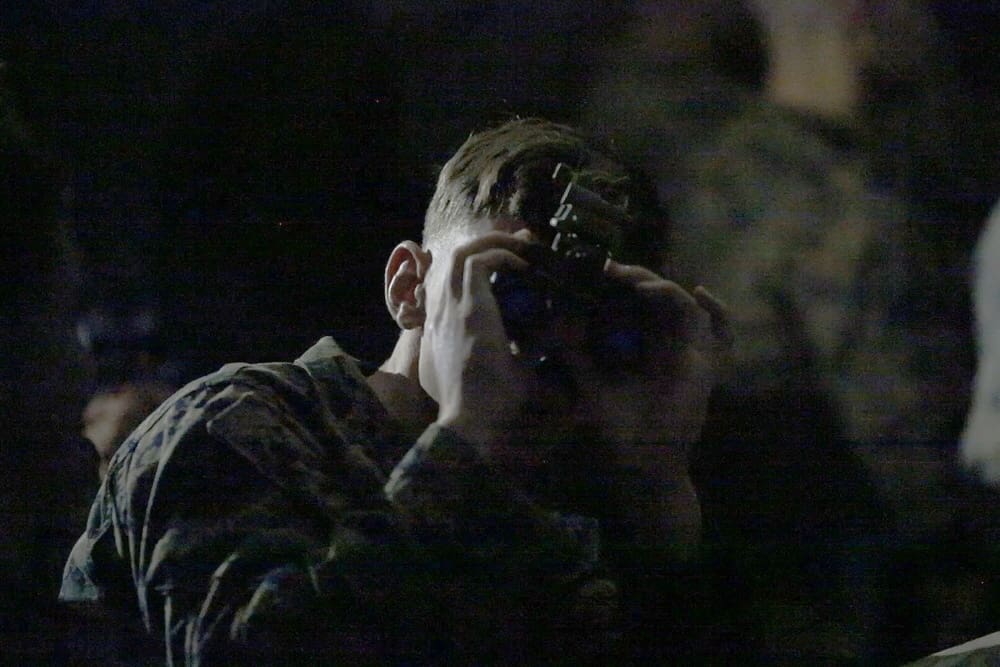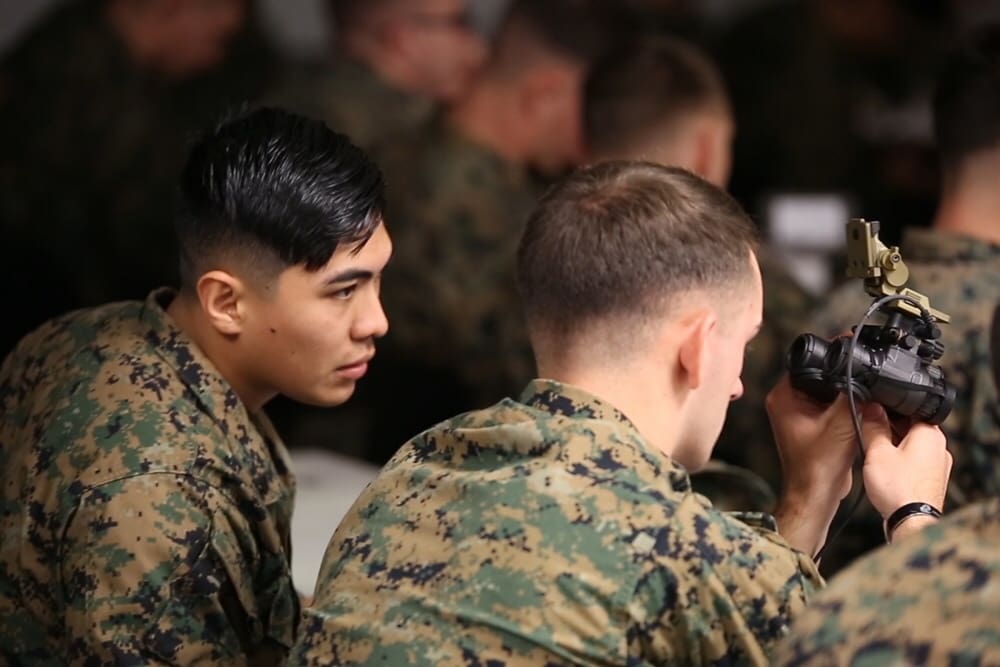An updated helmet-mounted night vision system is beginning to make its way to infantry units. Marine Corps Systems Command accelerated the acquisition of about 1,300 Squad Binocular Night Vision Goggles using existing Defense Logistics Agency contracts.
“We have employed a bridge capability to give Marines the best gear right now available in the commercial marketplace,” said Lt. Col. Tim Hough, program manager for Infantry Weapons. “A final procurement solution will allow a larger pool of our industry partners to bid on the program.”

A Marine peers through the lens of the Squad Binocular Night Vision Goggles during new equipment training in December 2018 at Camp Lejeune, North Carolina. The move to the SNBVG is expected to enhance the infantry’s lethality and situational awareness in reduced visibility (U.S. Marine Corps photo by Joseph Neigh)
Army/Navy Portable Visual Search devices, or AN/PVS, have been employed by the military since at least the 1990’s and upgraded with next-generation systems as funding and technology became available.
The move to the SNBVG is expected to enhance the infantry’s lethality and situational awareness in reduced visibility. It combines two systems: a binocular night vision device and an enhanced clip-on thermal imager.
“It’s a little bit lighter than the current system, and gives Marines better depth perception when they are performing movements,” said Joe Blackstone, Optics team lead at MCSC.

Marines took delivery of the Squad Binocular Night Vision Goggles during new equipment training in December 2018 at Camp Lejeune, North Carolina. The move to the SNBVG is expected to enhance the infantry’s lethality and situational awareness in reduced visibility. (U.S. Marine Corps photo by Joseph Neigh)
Marines took delivery of the equipment and learned how to use them last month at Camp Lejeune, North Carolina. Known as NET, the new equipment training entails teaching Marines about the operations, characteristics, maintenance and use of the new devices.
“The lethality that it’ll bring is exponential [sic],” said Cpl. Zachary Zapata, a Marine who participated in the training. “With these new [BNVGs], having the ability to not only use thermal optics along with it, but just the entire depth perception and speed that we can operate in is going to significantly increase, as opposed to what we were able to do in the past.”
The initial buy and follow-on procurement is being funded with Marine Corps dollars as prioritized by the Department of Defense Close Combat Lethality Task Force, which concentrates on the squad-level infantry and is aimed at ensuring close combat overmatch against pacing threats. The SBNVG acquisition strategy is to procure the devices incrementally and concurrently as the Corps looks toward future technologies.
“Right now, we are participating with the Army on their next generation night vision systems, both the Enhanced Night Vision Device-Binocular and Integrated Visual Augmentation System Programs,” Hough said. “We are eager to see the maturation of these capabilities for adoption to improve the effectiveness of our Marines.”
The program office plans on releasing a final request for proposals to procure an estimated 16,000 additional systems on the basis of full and open competition. According to program officials, a draft request for proposals was posted to the Federal Business Opportunities website in mid-November, and closed on Dec. 19, 2018. The Government is currently adjudicating comments and anticipates release of a final RFP in the near future.
Additional fielding of the systems is planned for September 2019. While the devices may eventually make their way to the entire Ground Combat Element, for now the first priority is given to the Marine Rifle Squad, program officials said.
“This program office is committed to bolstering the combat lethality, survivability, resilience and readiness of the GCE,” said Hough.
Story by Barbara Hamby, Marine Corps Systems Command


About time non-SOF dudes started getting binos in quantity… And the Soldier Requirements (Infantry Requirements?) office at Benning scoffed at me when I brought the subject up to them in 2016… “PVS14s and ENVGs are just fine.”
At least someone gets it.
It’s happening for the Army as well. ENVG-B
Yep, and about damn time, but I’m skeptical of the BII (haven’t seen a current MTOE proposal). I was talking to RFI in the early stages of that effort, glad it found a champion. Now that I’m out I don’t have the same visibility on it that I used to, but I know Geronimo’s (very succesful) use of -23s helped drive the discussion.
Sorry, that should read “BOI” – basis of issue.
ThatBlueFalcon, are you reading ThatGuy’s mind, or are you having a split online personality breakdown?
Why not both?
When are Army units supposed to start fielding dual tubes?
Have they released how many sets of ENVG-B they’ll be fielding or who will get them?
No, the contract was released but no specifics, hence my skepticism above. Big Army wanted white phos + thermals in the ENVG-B, so the cost is much higher. I suspect (given the $391m contract awarded) that procurement will be limited. Assuming that the contract cost PER SYSTEM is $20,000 (optimistic based on the -31 system cost), that means that AT MOST 19,550ea will be purchased. That barely covers 4x BCTs of Soldiers at 1 per grunt. Basically, a division’s worth of whiz-bang dual tubes.
In this case I believe that the Marines went with the smarter and more cost-efficient option.
FML, the Army once again goes too big for OER bullet points and us grunts get hosed? That’s my shocked face…
And if Big Army/Big USMC keep fielding good dual-tube NVGs, then maybe that’s one less item to spend SOCOM funds on.
Stop all the big picture stuff.
The BIG PICTURE is, all combat troops should have quality dual tube NVGs.
End of discussion. Period.
Yes. As of 2017, Ft. Benning disagreed. It looks like the Marines see the value in a simple set of dual tubes without adding more gadgetry.
Are these PVS1531 from L3 Warrior Systems??
Why do you ask? As per opsec the specific make and model, or possibly even this article doesn’t need to be released
They’re -31s. -15s are essentially obsolete.
finally the marines get pvs 14s lol
Can they just use a the new TNVC bridge device? Doesn’t that just combine two PVS-14’s? Also, can some of the binocular devices have your shooting eye freed up so you can get a cheek weld? Or are you just gonna use a laser and say good enough for government work?!?